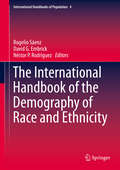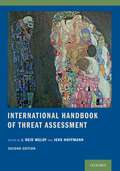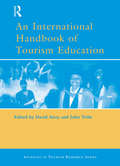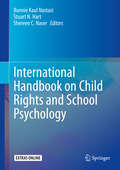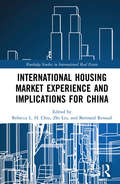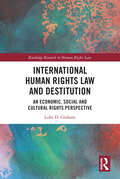- Table View
- List View
The International Handbook of the Demography of Race and Ethnicity (International Handbooks of Population #4)
by Rogelio Sáenz David G. Embrick Néstor P. RodríguezExamining key countries in every region of world, this handbook presents population profiles and analyses concerning racial/ethnic disparities and changing intergroup relations. Inside, prominent scholars from various parts of the world and disciplines address the links between stratification, demography, and conflict across the globe.Organized by region/continent, coverage for each profiled country includes demographic information; a historical overview that addresses past racial/ethnic conflict; identification of the most salient demographic trends and issues that the country faces; theoretical issues related to the linkages between stratification, demography, and conflict; methodological issues including quality of data and cutting-edge methods to better understand the issue at hand; and details on the possible future of the existing trends and issues with particular emphasis on public policy and human rights.This handbook will help readers to better understand the commonalities and differences that exist globally in the interplay between stratification, demography, and conflict. In addition, it also provides an excellent inventory of theoretical perspectives and methodological approaches that are needed to better comprehend this issue.This handbook will appeal to students, researchers, and policy analysts in the areas of race and ethnic relations, demography, inequality, international sociology, international relations, foreign studies, social geography, and social development.
International Handbook of Threat Assessment
by J. Reid Meloy, Jens HoffmannIn recent history, planned violent attacks have persisted in the United States and abroad. Ranging from targeted attacks on private individuals, public figures, schools, universities, corporations, and public venues, among others, these attacks have continued to illustrate the need for improved threat assessment and management efforts at local and national levels. In the few years since its publication in 2014, the International Handbook of Threat Assessment has become the gold standard textbook for the prevention of targeted violence. With this new edition, editors J. Reid Meloy and Jens Hoffmann have expanded their landmark text, reflecting the rise of scholarship and growth within the field of threat assessment and management. The book spans across disciplines and explores the foundations of threat assessment, the fields of practice in which it is utilized, and provides detail on practical applications from the most notable threat assessors and programs in North America, Europe, and Australia. Since the first edition, new chapters focusing on lone actor terrorism, insider threats, cyberthreats, the use of artificial intelligence, bystander effects, and enhanced interviewing techniques, offer new guidance for threat assessment professionals. International Handbook of Threat Assessment is the comprehensive resource for mental health practitioners, law enforcement, and professionals working to prevent targeted violence. This guide will serve as inspiration for further research and equip those working to intercept harm with the necessary tools for intervention.
International Handbook of Threat Assessment
In recent history, planned violent attacks have persisted in the United States and abroad. Ranging from targeted attacks on private individuals, public figures, schools, universities, corporations, and public venues, among others, these attacks have continued to illustrate the need for improved threat assessment and management efforts at local and national levels. In the few years since its publication in 2014, the International Handbook of Threat Assessment has become the gold standard textbook for the prevention of targeted violence. With this new edition, editors J. Reid Meloy and Jens Hoffmann have expanded their landmark text, reflecting the rise of scholarship and growth within the field of threat assessment and management. The book spans across disciplines and explores the foundations of threat assessment, the fields of practice in which it is utilized, and provides detail on practical applications from the most notable threat assessors and programs in North America, Europe, and Australia. Since the first edition, new chapters focusing on lone actor terrorism, insider threats, cyberthreats, the use of artificial intelligence, bystander effects, and enhanced interviewing techniques, offer new guidance for threat assessment professionals. International Handbook of Threat Assessment is the comprehensive resource for mental health practitioners, law enforcement, and professionals working to prevent targeted violence. This guide will serve as inspiration for further research and equip those working to intercept harm with the necessary tools for intervention.
An International Handbook of Tourism Education
by David Airey John TribeAs tourism matures as an academic subject and the number of tourism higher education providers continues to expand world-wide, there is an increasing interest in its educational aspects. At the same time the development of research into education issues related to tourism means that there is now a developing literature on the subject. This international handbook offers a timely evaluation of the sate of the art of tourism higher education. The book brings together expert contributors from around the world to present current thinking and practice about what is now a major element of education provision world-wide. It is structured round four key themes:- Curriculum- International perspective- Teaching, learning and assessment- Resources, progression and qualityIts global survey of tourism education offers a comprehensive basis for comparative review. In addition to setting out the development and current provision of tourism education it also addresses cutting edge issues such PhD education, non-formal education, cultural issues in learning, research and teaching, e-learning and e-assessment. It offers practical advice for the design, delivery, evaluation and resourcing of courses and concludes with a reflective agenda of issues for the future.
An International Handbook of Tourism Education (Advances In Tourism Research Ser.)
by David Airey John TribeAs tourism matures as an academic subject and the number of tourism higher education providers continues to expand world-wide, there is an increasing interest in its educational aspects. At the same time the development of research into education issues related to tourism means that there is now a developing literature on the subject. This international handbook offers a timely evaluation of the sate of the art of tourism higher education. The book brings together expert contributors from around the world to present current thinking and practice about what is now a major element of education provision world-wide. It is structured round four key themes:- Curriculum- International perspective- Teaching, learning and assessment- Resources, progression and qualityIts global survey of tourism education offers a comprehensive basis for comparative review. In addition to setting out the development and current provision of tourism education it also addresses cutting edge issues such PhD education, non-formal education, cultural issues in learning, research and teaching, e-learning and e-assessment. It offers practical advice for the design, delivery, evaluation and resourcing of courses and concludes with a reflective agenda of issues for the future.
International Handbook of Underwater Archaeology (The Springer Series in Underwater Archaeology)
by Carol V. Ruppe Jane F. BarstadAlthough underwater archaeology has assumed its rightful place as an important subdiscipline in the field, the published literature has not kept pace with the rapid increase in the number of both prehistoric and historic underwater sites. The editors have assembled an internationally distinguished roster of contributors to fill this gap. The book presents geographical and topical approaches, and focuses on technology, law, public and private institutional roles and goals, and the research and development of future technologies and public programs.
International Handbook of Violence Research
by Wilhelm Heitmeyer John HaganAn international manual is like a world cruise: a once-in-a-lifetime experience. All the more reason to consider carefully whether it is necessary. This can hardly be the case if previous research in the selected field has already been the subject of an earlier review-or even several competing surveys. On the other hand, more thorough study is necessary if the intensity and scope of research are increasing without comprehensive assessments. That was the situation in Western societies when work began on this project in the summer of 1998. It was then, too, that the challenges emerged: any manual, espe cially an international one, is a very special type of text, which is anything but routine. It calls for a special effort: the "state of the art" has to be documented for selected subject areas, and its presentation made as compelling as possible. The editors were delighted, therefore, by the cooperation and commitment shown by the eighty-one contributors from ten countries who were recruited to write on the sixty-two different topics, by the con structive way in which any requests for changes were dealt with, and by the patient re sponse to our many queries. This volume is the result of a long process. It began with the first drafts outlining the structure of the work, which were submitted to various distinguished colleagues. Friedheim Neidhardt of Berlin, Gertrud Nunner-Winkler of Munich, and Roland Eckert of Trier, to name only a few, supplied valuable comments at this stage.
International Handbook of White-Collar and Corporate Crime
by Henry N. Pontell Gilbert L. GeisInsider trading. Savings and loan scandals. Enron. Corporate crimes were once thought of as victimless offenses, but now—with billions of dollars and an increasingly global economy at stake—this is understood to be far from the truth. The International Handbook of White-Collar and Corporate Crime explores the complex interplay of factors involved when corporate cultures normalize lawbreaking, and when organizational behavior is pushed to unethical (and sometimes inhumane) limits. Featuring original contributions from a panel of experts representing North America, Asia, Europe, and Australia, this timely volume presents multidisciplinary views on recent corporate wrongdoing affecting economic and social conditions worldwide. Criminal liability and intent Stock market and financial crime Bribery and extortion Computer and identity fraud Health care fraud Crime in the professions Industrial pollution Political corruption War crimes and genocide Contributors offer case studies, historical and sociopolitical analyses, theoretical and legal perspectives, and comparative studies, featuring examples as varied as NASA, Parmalat, the Italian government, and Watergate. Criminal justice responses to these phenomena, the role of the media in exposing or minimizing them, prevention, regulation, and self- policing strategies, and larger global issues emerging from economic crime are also featured. Richly diverse in its coverage, The International Handbook of White-Collar and Corporate Crime is stimulating reading for students, academics, and professionals in a wide range of fields, from criminology and criminal justice to business and economics, psychology to social policy to ethics. This powerful information is certain to change many of our deeply held views on criminal behavior.
The International Handbook on Aging: Current Research and Developments (Non-ser.)
by Erdman P. Palmore Suzanne Kunkel Frank WhittingtonThe United Nations World Assembly on Aging has made advancing health and well-being into old age a worldwide call for action. And this text at hand shows us what researchers worldwide are doing to answer that call. Here, three of America's most esteemed experts on aging lead a global team of contributors - each an expert in his or her country - to show us what the top challenges of each nation are, and what top research is being done there to meet those. While we cannot predict with absolute certainty all of the issues that will arise over the next 20 years, we can anticipate some and we must start now to prepare for these challenges, an expert from the U.S. Department of Health and Human Services warned at a recent UN World Assembly on Aging. Needed response to the global population shift is not just the responsibility of governments, but will be a product of wise, long-term decisions made by individuals and societies, she explained.In most nations globally, populations are graying and the number of people aged 65 and older is vastly increasing, creating a larger segment of senior citizens than the world has ever before seen. Across human history, the elderly accounted for no more than 3 percent of the world population. By the year 2030, the elderly are expected to make up about 25 percent of the world population. And while longevity is of course seen as a great success, longer lifespan for such masses also creates dilemmas. For example, the incidence of dementia has already increased significantly with an 11-fold increase in people aged 65 and older in the US since the turn of the century, and a similar increase in aged people in Scotland has researchers there scrambling to find treatments for what they expect will be a 75 percent increase in dementia over the next 25 years. Chronic diseases that come with aging are already taxing health care systems in the US and around the world to Japan, with most experts aware their current health systems would be overrun and lack enough staff and facilities to handle the needs of an elderly population multiplying largely in the coming two decades. Increases in psychological issues such as dealing with the depression often striking aged people are impending, too, as are social issues such as how families, and public policies, will deal with the changing shape of the family.
International Handbook on Alcohol and Culture
by Dwight B. HeathThe first authoritative guide to how the world drinks, this reference details alcohol use in different countries and cultures. Variation is striking, with alcohol sometimes a food, a sacrament, a symbol, a tool, a tranquilizer, a medicine, a love potion, or an object of scorn—often with very different meanings and uses in a single country. This volume reveals multicultural and ethnic beliefs, practices, and attitudes about drinking around the world.An extensive introduction discusses the close link between alcohol and culture and provides a foundation for the rest of the book. Each of the following chapters is written by an expert contributor and discusses alcohol and culture in a particular country. Chapters discuss historical trends, drinking among ethnic and religious minorities, national policies, and social outcomes. Countries range from industrial nations known for their alcohol research, to developing nations and to places famous for drinking. A concluding chapter highlights important similarities and differences.
International Handbook on Child Rights and School Psychology
by Bonnie Kaul Nastasi Stuart N. Hart Shereen C. NaserThis handbook examines the meanings, implications, and transformative potential of a child-rights approach for school psychology. It focuses on the school community, in which psychology is committed to promoting well-being, learning, and development of all children. The handbook begins with an overview of the 1989 United Nations Committee on the Rights of the Child (CRC) and explores main themes such as, survival, protection, development, participation, and nondiscrimination. Chapters provide guidance in promoting and protecting child rights when dealing with critical issues relevant to the school community, including well-being, freedom from violence, and access to high quality education. In addition, chapters analyze and offer recommendations for child rights applications within the roles and responsibilities of school psychologists. The handbook concludes with future directions for achieving a child-rights approach for school psychology. Topics featured in this handbook include:The current status of child rights in the international community.Accountability for child rights by school psychology.Collaborative home, school, and community practices aimed at promoting family support.Protecting child rights within the realm of competitive sports.CRC and school-based intervention programming.Promoting child rights through school leadership.Applying child rights-respecting research to the study of psychological well-being. The International Handbook on Child Rights and School Psychology is a must-have resource for researchers, scientist-practitioners, clinicians, and graduate students in child and school psychology, educational policy and politics, social work, public health, and other school-based or child-serving mental health disciplines.
International Handbook on Gender and Demographic Processes (International Handbooks of Population #8)
by Nancy E. Riley Jan BrunsonThis handbook presents a comprehensive and up-to-date overview of gender in demography, addressing the many different influences of gender that arise from or influence demographic processes. It collects in one volume the key issues and perspectives in this area, whereby demography is broadly defined. The purpose in casting a wide net is to cover the range of work being done within demography, but at the same time to open up our perspectives to neighboring fields to encourage better conversations around these issues.The chapters in this handbook carefully document definition and measurement issues, and take up parts of the demographic picture and focus on how gender plays a role in outcomes. In other cases, gender often plays a cross-cutting role in social processes; rather than having a single or easily distinguishable role, it often combines with other social institutions and even other statuses and inequalities to affect outcomes. Thus, a key factor in this volume is how gender interacts with race/ethnicity, class, nationality, and sexuality in any demographic setting.While each section contains chapters that are broad overviews of the current state of knowledge and behavior, the handbook also includes chapters that focus on specific cultures or events in order to examine how gender operates in a particular circumstance.
International Handbook on Geographical Education (GeoJournal Library #73)
by Rod GerberI am very pleased to have been asked by Rod Gerber to provide a preface to such a book. Not least because of the twenty-four chapters, eight are written by former students or colleagues with whom I have worked in the past and whom I still meet at conferences on geographical education. It is with a certain pride and joy that I note the progress which has been made in geographical education both in its day to day teaching and in research, in the twenty years following the end of my term of office as Chair of the Commission on Geographical Education of the International Geographical Union (CGEIUG). My successors, Joe Stoltman, Hartwig Haubrich, Rod Gerber and now Lea Houtsonen, have done much and are continuing to work hard, to foster the development of geographical education. This book is proof, if proof were needed, that the international collaboration in this field, is alive and well, with contributions coming from all the continents (except Antarctica!). It would be a moribund subject that remained unaffected in one way or another by developments on the 'great world stage', as Fairgrieve (1926) would have put it. And, as Rod Gerber shows, the issues of globalisation, of cultural encounters, of differing value systems, of new technologies, of variable economic development and of environmental quality, all feature as topics which influence and are influenced by, geographical education.
International Handbook on Responsible Innovation: A Global Resource
by Jonathan Hankins René Von SchombergThis Handbook constitutes a global resource for the fast-growing interdisciplinary research and policy communities that have taken on the challenge of driving innovation towards socially desirable outcomes. The collection brings together well-known authors from the USA, Europe, Asia and South Africa, developing conceptual and regional perspectives on responsible innovation including issues of governance, economics and ethics. The authors explore the prospects for the further implementation of responsible innovation in emerging technological practices in sectors from agriculture and health-care to nanotechnology, robotics and artificial intelligence. The collection emphasizes the socio-economic and normative dimensions of innovation, including issues of social risk and sustainability.
International Handbook on the Demography of Marriage and the Family (International Handbooks of Population #7)
by Karista K. Hughes Elizabeth Harmon ThreattThis handbook provides a global perspective on contemporary demographic theories and studies of marriage and the family. Inside, readers will find a comprehensive analysis that enables demographic comparison between and across international borders. Coverage is centered around four main sections that present a history of marriage and the family, detail relevant data and measurement concerns, examine global marriage practices, analyze interactions of such demographic characteristics as age, sex, and race with marriage and the family, and consider public policy, contemporary trends, and future directions. In addition, the book includes research on current social issues such as alternative family structures, cohabitation, divorce, boomerang children, and adoption. The family is universal but extremely varied in form and function. This handbook provides students, researchers, and policymakers with an all-inclusive, international demographic analysis that fully investigates the diverse nature of the modern family.
International Handbook on the Demography of Sexuality (International Handbooks of Population #5)
by Amanda K. BaumleThe International Handbook on the Demography of Sexuality is the first book to specifically address the study of sexuality from a demographic perspective. Demographic research has largely paid little attention to sexuality as a whole, or sexual orientation in particular, other than in studies examining the “consequences” of sex – sexually transmitted infections or fertility. Instead, the content of this handbook explores population sexuality in order to describe the prevalence of sexual behaviors, desires, and identities, as well as their connections with other demographic outcomes. The focus is on analyzing sexuality as a demographic topic in its own right, rather than solely as a variable in studies of sexually transmitted infection or other health-related topics. In this book, both researchers with traditional demographic backgrounds, as well as those with training in other disciplines, provide an overview of the state of current research on population sexuality. These chapters provide a foundation for the development of research in the burgeoning field of the demography of sexuality.
International Historical Statistics: Africa, Asia & Oceania, 1750–1993 (International Historical Statistics)
by Brian MitchellInternational Historical Statistics: Africa, Asia, Oceania is the latest edition of the most authoritative collection of statistics available. Fully updated to 1993, it provides key economic and social indicators for the last 250 years. The volume includes both hard to find historical data, and the latest figures available.
International Historical Statistics: Europe 1750-1993 (International Historical Statistics)
by Brian MitchellInternational Historical Statistics: Europe is the latest edition of the most authoritative collection of statistics available. Fully updated to 1993, it provides key economic and social indicators for the last 250 years of European countries, from employment figures by occupation to annual output of wheat. Hard to find historical data is conveniently gathered together with the latest figures.
International Housing Market Experience and Implications for China (Routledge Studies in International Real Estate)
by Rebecca L. H. Chiu Zhi Liu Bertrand RenaudRecent rapid housing market expansion in China is presenting new challenges for policy makers, planners, business people, and citizens. Now that housing in middle-income China is driven by consumer choices and is no longer dominated by state policy decisions, housing policy issues in Chinese cities are becoming increasingly similar to those encountered in other global housing markets. With soaring prices and imbalances in housing supply favoring high income groups and housing demand driven by rising inequality in household incomes, many middle and lower-income households face worsening choices in terms of the quality and location of their housing as well as greater financial difficulties, which together can have negative implications for standards of public health. This book examines the impact of these changes on the general population, as well as on aspiring homeowners and developers. The contributors look at the effect on the widening of wealth gaps, slower economic growth, and threats to political and social stability. Though focusing on China, the editors also present discussions of specific policy design challenges encountered in Australia, Japan, Korea, the Netherlands, the Nordic countries, Singapore, Taiwan, the UK, and the US. This book would be of interest to housing policy makers, as well as academics who are studying the social and political effects of the Chinese housing market.
International Housing Market Experience and Implications for China (Routledge Studies in International Real Estate)
by Rebecca L. H. Chiu Zhi Liu Bertrand RenaudRecent rapid housing market expansion in China is presenting new challenges for policy makers, planners, business people, and citizens. Now that housing in middle-income China is driven by consumer choices and is no longer dominated by state policy decisions, housing policy issues in Chinese cities are becoming increasingly similar to those encountered in other global housing markets. With soaring prices and imbalances in housing supply favoring high income groups and housing demand driven by rising inequality in household incomes, many middle and lower-income households face worsening choices in terms of the quality and location of their housing as well as greater financial difficulties, which together can have negative implications for standards of public health. This book examines the impact of these changes on the general population, as well as on aspiring homeowners and developers. The contributors look at the effect on the widening of wealth gaps, slower economic growth, and threats to political and social stability. Though focusing on China, the editors also present discussions of specific policy design challenges encountered in Australia, Japan, Korea, the Netherlands, the Nordic countries, Singapore, Taiwan, the UK, and the US. This book would be of interest to housing policy makers, as well as academics who are studying the social and political effects of the Chinese housing market.
International Human Resource Management in Japanese Firms: Their Greatest Challenge
by T. KeeleyThis book examines possibly the greatest challenge facing Japanese multinationals as they continue to expand their foreign direct investment: how to integrate local managers into the management process of overseas subsidiaries as well as in that of the parent companies themselves. In the majority of Japanese subsidiaries, management control has remained in the hands of Japanese managers at extremely high cost, but now Japanese firms are being forced to consider integrating local nationals into the management process of their companies, a process which may yield significant competitive advantage.
The International Human Right to Freedom of Conscience: Some Suggestions for Its Development and Application (Routledge Revivals)
by Leonard M HammerThis title was first published in 2002: This text addresses the problem of conflict that arises between the human right to freedom of religion and the human right to freedom of belief, for example, certain religious beliefs are in conflict with certain women's rights. The pricipal goal of this book is to distinguish between the more formalized, and recognized, notion of protecting religious beliefs from what is referred to as conscientious beliefs - a belief external to a religious context.
The International Human Right to Freedom of Conscience: Some Suggestions for Its Development and Application (Routledge Revivals)
by Leonard M HammerThis title was first published in 2002: This text addresses the problem of conflict that arises between the human right to freedom of religion and the human right to freedom of belief, for example, certain religious beliefs are in conflict with certain women's rights. The pricipal goal of this book is to distinguish between the more formalized, and recognized, notion of protecting religious beliefs from what is referred to as conscientious beliefs - a belief external to a religious context.
International Human Rights Law and Destitution: An Economic, Social and Cultural Rights Perspective (Routledge Research in Human Rights Law)
by Luke D. GrahamThis book explores destitution from the perspective of International Human Rights Law and, more specifically, Economic, Social and Cultural Rights. The experience of destitution correlates to the non-realisation of a range of economic, social and cultural rights. However, destitution has not been defined from this perspective. Consequently, the nexus between destitution and the denial of economic, social and cultural rights remains unrecognised within academia and policy and practice. This book expressly addresses this issue and in so doing renders the nexus between destitution and the non-realisation of these rights visible. The book proposes a new human-rights-based definition of destitution, composed of two parts. The rights which must be realised– the component rights – and the level of realisation of these rights which must be met – the destitution threshold – to avoid destitution. This human rights-based understanding of destitution is then applied to a UK case study to highlight the relationship between government policy and destitution, to illustrate how destitution manifests itself, and to make recommendations – founded upon engendering the realisation of economic, social and cultural rights – aimed towards addressing destitution. This book will have global and cross-sectoral appeal to anti-poverty advocates, policy makers, as well as to researchers, academics and students in the fields of human rights law, poverty studies, and social policy.
International Human Rights Law and Destitution: An Economic, Social and Cultural Rights Perspective (Routledge Research in Human Rights Law)
by Luke D. GrahamThis book explores destitution from the perspective of International Human Rights Law and, more specifically, Economic, Social and Cultural Rights. The experience of destitution correlates to the non-realisation of a range of economic, social and cultural rights. However, destitution has not been defined from this perspective. Consequently, the nexus between destitution and the denial of economic, social and cultural rights remains unrecognised within academia and policy and practice. This book expressly addresses this issue and in so doing renders the nexus between destitution and the non-realisation of these rights visible. The book proposes a new human-rights-based definition of destitution, composed of two parts. The rights which must be realised– the component rights – and the level of realisation of these rights which must be met – the destitution threshold – to avoid destitution. This human rights-based understanding of destitution is then applied to a UK case study to highlight the relationship between government policy and destitution, to illustrate how destitution manifests itself, and to make recommendations – founded upon engendering the realisation of economic, social and cultural rights – aimed towards addressing destitution. This book will have global and cross-sectoral appeal to anti-poverty advocates, policy makers, as well as to researchers, academics and students in the fields of human rights law, poverty studies, and social policy.
